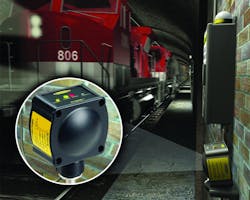While trains are typically quite significant in size and in the amount of cargo and/or people they carry, they can be surprisingly difficult to sense. In fact, most traditional sensing technologies come up short when it comes to various train detection applications. Due to the range of environmental factors that can interfere with reliable detection of moving and stationary trains, a new type of radar-based sensor often provides the best solution for these challenging applications.
For instance, photoelectric sensors, a type of optical sensor, are an impractical solution for train detection applications since the accumulation of dirt and dust would eventually inhibit the sensor’s ability to deliver accurate results. While high-powered emitter/receiver pairs could be used to combat this issue, the sensors would then need to be wired on both sides of the track — requiring expensive extra wiring. Ultrasonic sensors aren’t impacted by dust and dirt build-up, but they are prone to interference from the wind generated by passing trains, as well as the squeaking wheels on the tracks. Additionally, since some trains are powered by electricity, the current created would interfere with results if a magnetic sensor were used.
Unlike optical-, sound- and magnetic-based sensor technologies, radar sensors resist all these challenging environmental conditions. Doppler radar would work as long as the trains were moving, but these sensors would be incapable of detecting stopped trains. However, frequency modulated continuous wave (FMCW) radar-based sensors —designed with the challenges of train detection in mind — provide reliable detection of moving and stationary objects in areas where other sensors cannot deliver.
What are FMCW radar-based sensors?
FMCW sensors are available in two modes: adjustable-field and retroreflective. Adjustable-field radar sensors consist of an emitter, which sends a defined beam of high-frequency radio waves from an internal antenna. This antenna then processes the signal reflected back to the receiving antenna, detecting the presence of objects in its path. FMCW sensors in adjustable-field mode are commonly used for detection of vehicles on roads and near intersections, boat detection for locks and dams, and car counting for parking ramps, gates and drive-thrus. Mass transit applications include subway and light rail logistics, detailed more below.
The retroreflective mode adds a retro-target — which serves as a reference signal — to this arrangement, allowing the sensor to effectively detect stationary targets with poor or no radar reflection. By emitting the same high-frequency radio waves as the adjustable-field model, sensors in retroreflective mode deliver a narrow effective sensing beam and ignore objects in the background beyond the retroreflective target. This creates a more focused sensor with the ability to sense targets up to the sensor face — eliminating dead zones. Retroreflective mode radar sensors can be used for a broad range of traffic, materials handling and logistical applications, including tollbooths, gate control and parking ramps. Additionally, sensors in this mode are used for train detection and shipyard logistics.
Challenging Train Detection Applications
Due to its ability to “see” through environmental hazards, FMCW radar-based sensors provide an ideal solution for various train detection applications. For example, a system using FMCW sensors can be used to detect trains for switchyard logistics, locate subway or railway cars in underground tunnels or monitor light rail trains at intersections.
Most passenger trains, subways and light rail trains are composed of uniform, tall metal cars, which act as excellent radar targets that are easily detected with adjustable-field mode sensors. For these applications, the sensor is mounted high off the ground, looking directly across the tracks to receive a perpendicular reflection off of the upper sides of rain cars. Radar sensors typically have wide beam patterns, up to plus or minus 45 degrees, so the sensor must be mounted high enough so that the train tracks themselves are not in the field of view. Adjustable-field mode sensors can also be mounted lower if they are aimed down the track at an angle toward oncoming trains. When aimed at an angle to the tracks, the beam will deflect off of the tracks, preventing interference. An FMCW sensor in this configuration could provide both presence and speed or direction information.
However, some train detection situations can be much more challenging. Cargo trains have a varied assortment of cars, including flatbeds of multiple heights, and cars carrying radar-absorbing targets such as wood or coal. In the case of radar absorbing targets, a retroreflective mode sensor can be used, as it will detect the loss of the reference signal due to the radar absorbing target. The reference target can be a concrete or brick wall on the other side of the train, such as in tunnels, or the sensor can be aimed down at the tracks, using the tracks as a reference target. Stand alone radar targets can also be mounted on posts opposite the sensor. If using a strong reference target, the retroreflective sensor can be mounted lower to the ground since it has a narrower effective beam pattern, allowing it to detect empty flatbed cars.
There are also high-gain, intrinsically narrow-beam FMCW radar antennas that can also be mounted lower to the ground without seeing the tracks, allowing them to reliably detect empty flatbed cars in adjustable-field mode, without requiring a reference target.
Another solution to the variety of train cars — which has already been implemented in several underground and above ground train lines — is simply to use many radar sensors periodically spaced along the tracks. Then even if one sensor misses an empty flatbed, neighboring sensors will still pick up the presence of the train.
In today’s tough economical climate and due to an increased focus on lowering people’s environmental footprints, more and more people are opting to regularly use various types of mass transportation. The resulting increased demand on existing trains, subways and light rails, as well as the construction of new modes of mass transit, make reliable detection and tracking methods more important than ever before.
Ashley Wise is a development engineer at Banner Engineering.


